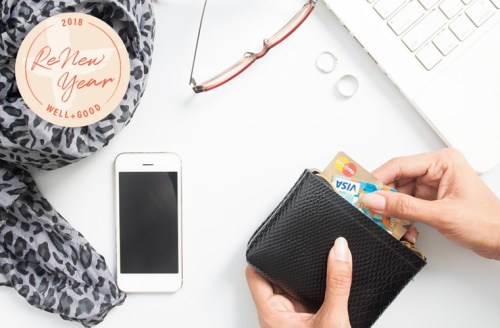3 tips for finding the right credit card for your lifestyle
Financial expert Farnoosh Torabi explains what to look for when choosing a credit card—and how to use one to build financial strength, not go into debt.

If you have a history of debt, getting a credit card can feel risky. But, when used the right way—i.e., by paying off your balance each month, not using your plastic to splurge on daily spin classes or leggings you can’t afford—it can be a powerful way to build financial strength. Here, Chase Slate Financial Education Ambassador Farnoosh Torabi shares her top tips for finding the right credit card for your needs.

Before you can expect anybody else to give you credit, you’re going to have to give yourself some. We live in a credit-oriented society—if you want to rent an apartment, buy a car, take on a mortgage, take out a loan to go back to school or start a business, you’ll need to show proof of established credit history. The easiest way to establish said history? With a credit card.
If you’re trying to break bad money habits, a credit card might seem like the fastest way to derail your budget. But it’s just a piece of plastic—it isn’t anything to be fearful of. And these days, having a credit card is almost non-negotiable for someone looking to improve their financial standing.
Here’s how to choose the right one for you—and how to keep its use in check.

1. Consider your priorities
Think about your lifestyle. Do you travel a lot? Manage most of your household’s expenses? If you fly a specific airline, like Delta or Jet Blue, fairly often, it might make sense to look at a card that can reward you for consistent travel on those carriers. If you’re someone who plans to use your card to streamline your expenses (e.g. your car payment, electricity, student loans), you’ll want to look for a card that will award you points—or cash back—that you can use towards other purchases or to pay off your principal. It’s really about what card is going to give you the most bang for your credit buck.
If you’re currently dealing with credit card debt, you might also be somebody who’s looking to reduce your interest rate by transferring the balance. In that case, you’re going to want to choose a card that has a low interest rate (in financial speak, “annual percentage rate,” or APR) for a period of time. Chase Slate, for example, offers a 0 percent APR for the first 15 months, which makes it especially appealing to people who are transferring previous balances. That low APR means you’ll be able to devote more of your money to paying down the principal—AKA, your debt.
One final word on interest rates: The average APR is around 16.15 percent. Be careful not to get stuck with an interest rate much higher than that. That said, if you’re not planning to carry a balance from month to month (and you shouldn’t!), you won’t really have to worry about the interest rate. Focus instead on the benefits your card provides.

2. Read the fine print
Before you sign up for a credit card, always read the terms and conditions. (Alway, always, always!) Some of the financial terminology might feel like another language, but be on the lookout for restrictions that might make the card not worth your while. Sometimes people open up cards and later realize there’s an annual fee attached. If you’re using the card consistently and responsibly and getting cash back, that will often make up for the cost of carrying the card. But if you’re only using that card for a handful of bills, the annual fee may end up feeling like more of a financial burden.
Likewise, if you dig a little deeper with a miles- or points-based card, you might realize you’re faced with a ton of blackout dates, meaning you may not be able to use the benefits you’ve earned when you actually need them.
On the flip side, some cards come with benefits you had no idea existed, like purchase protection, free extended warranties on big purchases, and travel insurance.

3. Start small
If you’re establishing credit for the first time or trying to improve your credit profile, the key is keeping your credit utilization ratio as low as you can. (That’s the ratio of your balance to your “maxed out” amount.) A good rule of thumb is to use no more than 10 percent of the credit available to you at a time. To give you a concrete example, if you have a $10,000 credit limit on a card, you should be using no more than $1,000 of that at once.
If overspending is a concern, most cards offer tools to help you keep close track of your balance. For example, you may be able to set up an alert so you get a text or email every time your balance climbs above a certain amount. That’s sometimes a nice little nudge to remind you, Okay, be careful this weekend, or, Enough is enough.
To keep your cards working for you—and not against you—don’t take on more debt than you can manage. You should, ideally, be paying off your balance in full every month. If you just don’t want to put yourself in the position of having access to an all-too-convenient credit card during shopping trips or nights out with friends, leave the plastic at home. Use it only to pay off a recurring bill or two every month—say, your cell phone bill or your student loans—and use cash for everything else. Slowly but surely, you’ll build a solid credit profile, which means you’ll have greater access to affordable credit that can help you achieve whatever it is you want out of life.
Farnoosh Torabi is one of America’s leading personal finance authorities. From her early days reporting for Money magazine to hosting a primetime series on CNBC to becoming a Chase Slate Financial Education Ambassador, she’s become a go-to money expert. Millions of Americans tune into Farnoosh’s award winning podcast, So Money, and her work and advice have been featured in The New York Times, The Wall Street Journal, O, The Oprah Magazine, Fortune, Forbes and Time. For more, check out www.Farnoosh.TV.
Make 2018 your healthiest, happiest, and richest yet—with a little help from Well+Good’s (Re)New Year program!









